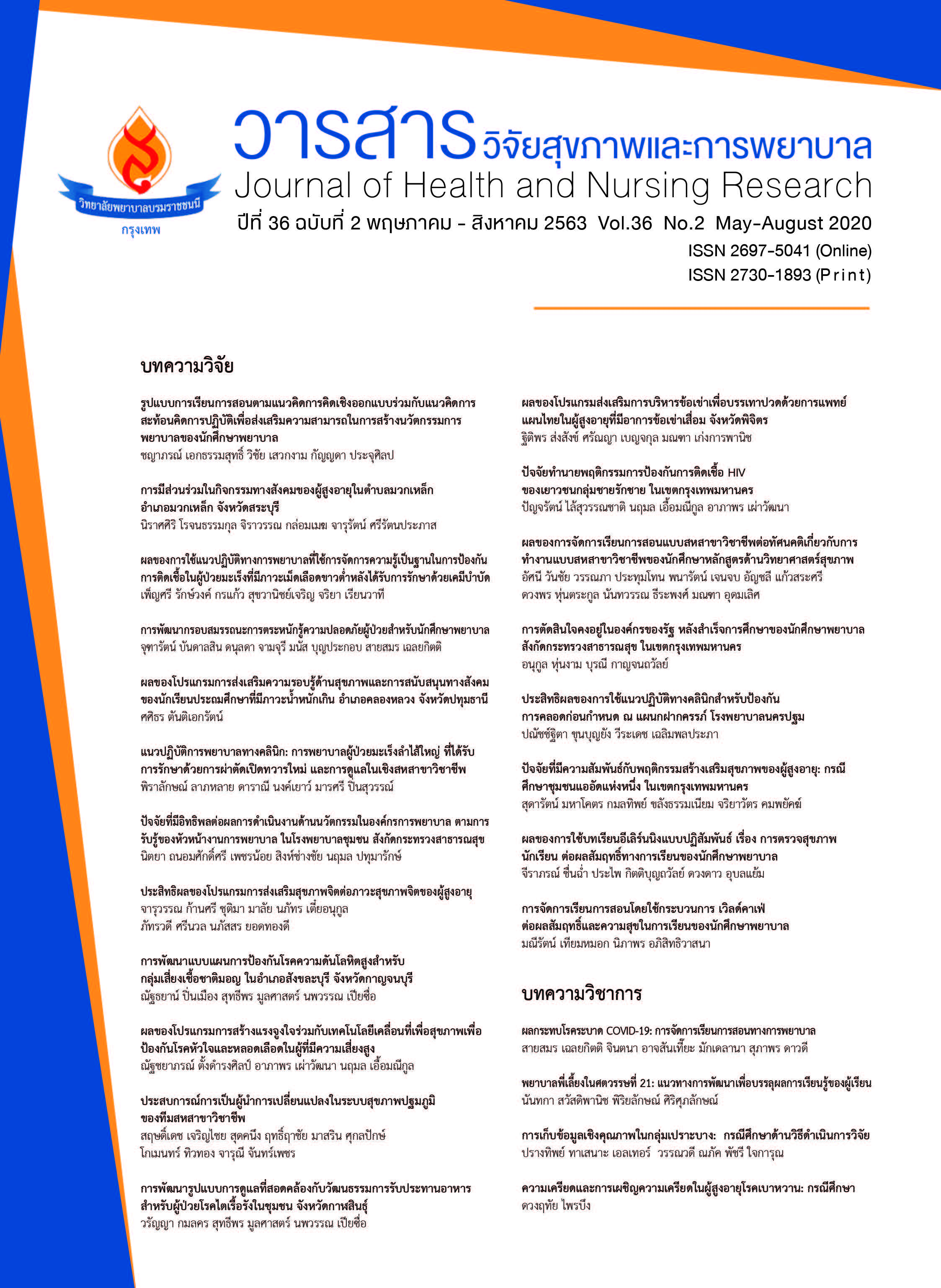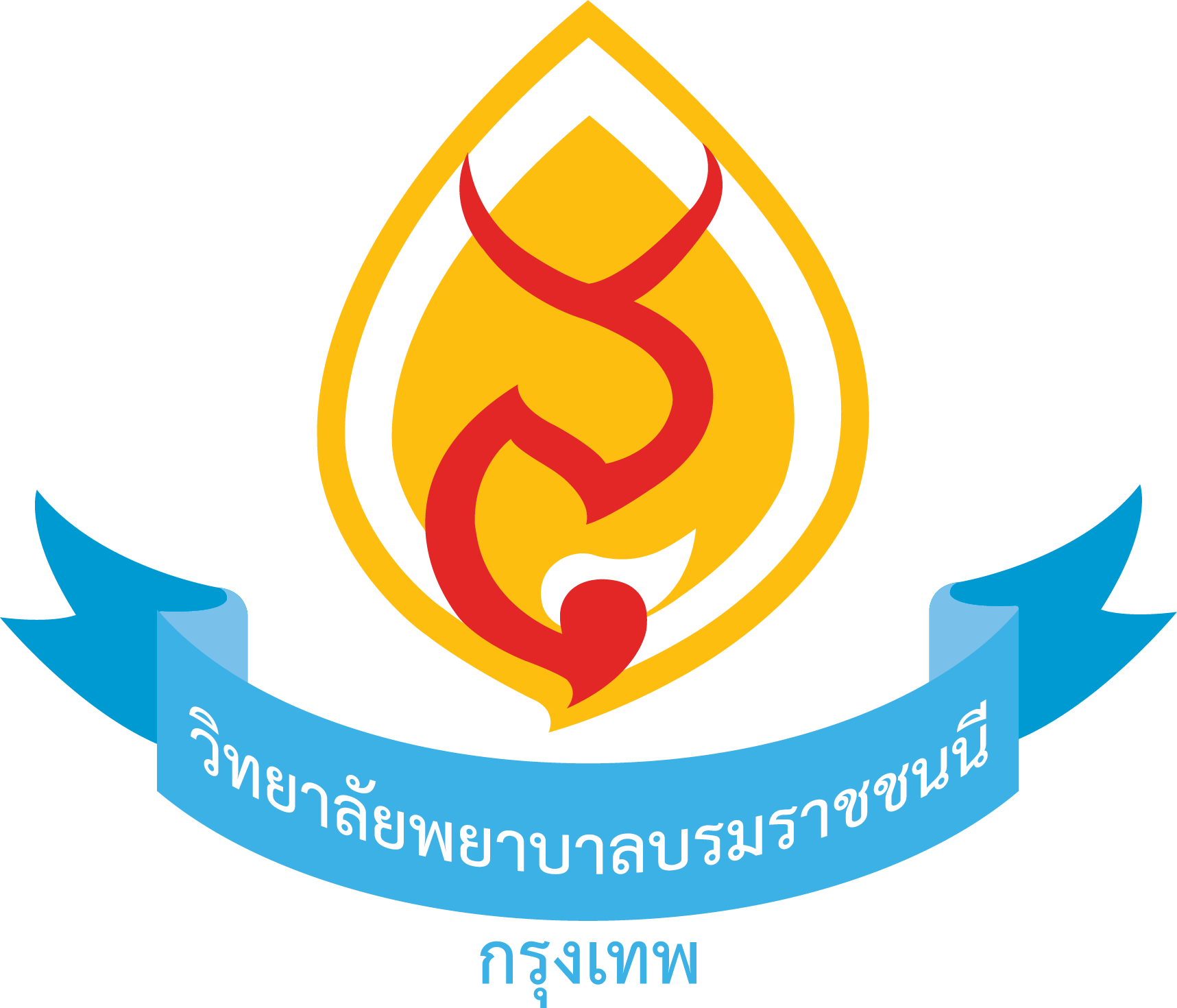Factors Influencing Innovation Performance in Nursing Organizations as Perceived by Head Nurses of Community Hospitals under the Ministry of Public Health
Keywords:
innovation performance, influencing factors, head nurses, community hospitalsAbstract
Innovation performance is one of the most important for an organization to have competitive advantage. The objective of this analytical research was to investigate factors influencing innovation performance in nursing organizations. The subjects of the study were 305 head nurses of community hospitals under the Ministry of Public Health; the sample size was calculated using Krejcie & Morgan formula. The research instrument was a 5-point rating scale questionnaire consisting of 5 parts: personal factors, team factors, organizational factors, environmental factors and innovation performance. The questionnaire was validated in terms of content by five experts and the content validity index (CVI) was between 0.95-1.00 and for the reliability, Cronbach’s coefficient alpha was 0.90, 0.95, 0.93, 0.93. Then, data were analyzed with descriptive statistics and hierarchical multiple regression. The study found that the innovation performance in nursing organizations was at a high level (Mean= 3.51,
SD. = 0.70) while personal factors could help predict 7 percent (R2 = 0.07, F = 5.11) of innovation performance of the nursing organizations; team factors could predict 46 percent (R2 = 0.46, F = 32.18) to increase 39 percent ( R2 = 0.39) ; organizational factors could predict 66 percent (R2 = 0.66, F = 49.44) to increase 20 percent (R2 = 0.20) of the innovation performance, and environmental factors could predict 68 percent of the innovation performance (R2 = 0.68, F = 45.59) to increase 2 percent ( R2 = 0.02) at a statistical significance level (p<0.05). When considering the sub-variables of each factor, it was found that the sub-variables influencing innovation performance of nursing organizations were innovation
experience (β = 0.11), innovation training (β =0.20), team planning (β =0.62), hospital size (β = 0.08), eadership behavior (β = 0.30), innovation climate (β = 0.36), and use of technology and information (β =0.19). The predictive equation was Y (innovation performance) = 0.80+0.16 (innovation experience) + 0.26 (innovation training) + 0.44 (team innovation planning) + 0.15 (hospital size) + 0.25 (leadership behavior)
+ 0.32 (innovation climate) +0.27 (technology and information). Thus, the body of knowledge resulting from this study could be utilized by nursing organization administrators by using these factors to drive innovation performance of nursing organizations to achieve organizational goals with more efficiency and effectiveness.
effectiveness.
Downloads
References
2. Jafri MH. Organizational commitment and employee’s innovative behavior: a study in retail sector. Journal of Management Research 2010;10:62-68.
3. Pundt A, Martins E, Nerdinger FW. “Innovative behavior and the reciprocal Exchange between employees and organizations”, German Journal of Human Resource Management:Zeitschrift fur Personal forschung 2010;24(2):173-93.
4. Pyka A, Hanusch H. Social innovations in the perspective of Comprehensive Neo-Schumpeterian Economics. Parra Rodríguez; 2013
5. Damanpour F, Schneider M. 'Characteristics of innovation and innovation adoption in public organizations: assessing the role of managers'. Journal of Public Administration Research and Theory 2009;19(3):495-522.
6. Osborne SP, Brown L. 'Innovation, Public Policy and Public Services Delivery in The UK. The Word that Would Be King, Public Administration b 2011;89(4):1335-50.
7. Walker RM. ‘Internal and External Antecedents of Process Innovation: A Review and Extension’. Public Management Review 2014;16(1):21-44.
8. ICN. Delivering quality, serving communities: nurses leading care innovations. Retrieved from http://www.icn.ch/publications/2009-delivering-qualityserving- communities-nurses-. 2009.
9. Mcsherry R, Douglas M. Innovation in nursing practice: a means to tackling the global challenges facing nurses, midwives and nurse leaders and managers in the future. Journal of Nursing Management 2011;19(2):165-9.
10. Najm A, Alhmeidiyeen MS. Impact of Change Management Dimensions on Performance. European Journal of Business and Management 2015;7(12):185-95. Criteria at Greater Amman Municipality (GAM)
11. Omachonu VK, Einspruch NG. Innovation in healthcare delivery systems: a conceptual framework. The Innovation Journal: The Public Sector Innovation Journal 2010;15(1):1-20.
12. Lee SM, Trimi S. Innovation for creating a smart future. Retrieved from www.elsevier.es/enrevista-journal-innovation-knowledge-376-pdf-S244; 2016.
13. OECD. Oslo Manual : Guidelines for collecting and interpreting innovation data. A joint publication of OECD and Eurostat; 2005.
14. Adair J. Leadership for Innovation: How to Organize Team Creativity and Harvest Ideas.Kogan Page, London; 2009.
15. Vrise HD, Bekkers V, Tummers L. Innovation in the Public Sector: A Systematic Review and Future Research Agenda. Public Administration 2016;94(1):146–66.
16. Thanomsaksri N, Singchangchai P, Pathumarak N. Leadership and organizational innovation for public sector: a systematic review. Journal of Health and Nursing Research 2562;35(3):1-15. (in Thai)
17. Krejcie RV, Morgan DW. Determining sample size for research activities. Educational and Psychological Measurement 1970:30:607-10.
18. DeVellis RF. Scale development: theory and applications. London : SAGE Publication Ltd; 2012
19. Crossan MM, Apaydin MA Multi-Dimensional Framework of Organizational Innovation : A Systematic Review of the Literature. Journal of Management Studies 2010;47(6):1154-91.
20. Zhang Y, Zheng J, Darko A. How does transformational leadership promote innovation in construction? The Mediating Role of Innovation Climate and the Multilevel Moderation Role of Project Requirements. Sustainability 2018;10:1-19.
21. Abood S, Thabet M. Impact of Leadership Styles on Decision Making Styles among Nurses' Managerial Levels. 2017;34(3):7-11.
22. Falck O, Heblich S. Training and innovation. Journal of Human Capital. 2009;3(4):323-53.
23. Dostie, B. The impact of Training on Innovation: ILR Review. Journal permissions, 2018;71(1):64-87.
24. Mokekhaow K. The Relationship Model among Transformational Leadership, Knowledge Creation and Innovation Management Performance in Nursing Units at Community. (in Thai).
25. Marquis BL. Huston CJ. Leadership roles and management functions in nursing: Theory and Application (7thed.). Philadelphia: Wolters Kluwer Health; 2012.
26. Li, Q., She, Z., & Yang, B. Promoting Innovative Performance in Multidisciplinary Teams: The Roles
of Paradoxical Leadership and Team Perspective Taking. Frontiers in Psychology, 2018; 9(2), 1-10.
27. Lin, C. U. Influences of Individual, Organizational and Environmental Factors on Technological
Innovation in Taiwan’s Logistics Industry. Journal of Technology Management & Innovation, 2011;
6(4), 1-8.
28. Beyene, K. T., Chi, C. S., & Wu, W. W. The Impact of Innovation Strategy on Organizational Learning
and Innovation Performance: DO Firm Size and Ownership Type Make a Difference. South African
Journal of Industrial Engineering, 2016; 27(1), 125-136.
29. Mullins, L. J. Management & Organizational Behavior. United Kingdom; Pearson Education Limited,
2013
30. Denti, L. & Hemlin, S. Leadership and Innovation in Organization: A Systematic Review of Factors
that Mediate or Moderate the relationship. International Journal of Innovation Management, 2012;
16(3), 1-20.
31. Ricard MA. Innovation capacity in the public sector: What’s the link between leadership and innovation?. research results from the LIPSE project on Innovation in the public sector funded by the 7th Framework Program of the European Union; 2014.
32. Wang, P., Rode, J. C., Shi, K., Luo, Z., & Chen, W. A workgroup climate perspective on the relationships among transformational leadership, workgroup diversity, and employee creativity. Group & Organization Management, 2013; 38(3), 334–60.
33. Khan, Z. A., Nawazl, A., & Khan, I. The impact of leadership style on innovation in health service. Gomal University Journal of Research [GUJR], 31(1); 2015;143-54.
34. Amri, A. Y., Hassan, R., Isaac, O. & Masoud, Y. The Effect of Transformational Leadership on Organizational Innovation in Higher Education: The Case of Developing Countries. International Journal of Management and Human Science (IJMHS), 2018; 2(4) 25-37.
35. Muchtar, Y. C. The Influence of Transformational Leadership Style on Innovation Mediated by Organizational Culture. Journal of Management Research, 2014;6(4):76-186.
36. Arons, A. G. & Sommerfeld, D. H. Leadership, Innovation Climate, and Attitudes toward Evidence Based Practice during a Statewide Implementation. J Am Acad Child adolesc Psychiatry, 2012;51(4):1-15.
37. Ali, K. A. & Buang, M. Study on Factors that Influence Innovation in Malaysian Public Sector. Journal of Advanced Research in Business and Management Studies 2016;4(1):60-73.
38. Vargas, H. C, Estrada, S. & Gómez, E. L. The effects of ICTs as innovation facilitators for a Greater. Procedia Computer Science, 2016;9 (1):47 – 56.
39. Jabbouri, N. I., Siron, R., Zahari, I., & Khalid, M. Impact of Information Technology Infrastructure on Innovation Performance: An Empirical Study on private Universities In Iraq. Procedia Economics and Finance 2016;39:861-869.
Downloads
Published
How to Cite
Issue
Section
License
Article published Is the copyright of the Journal of Health and Nursing Research (Boromarajonani College of Nursing, Bangkok) Cannot be republished in other journals


















